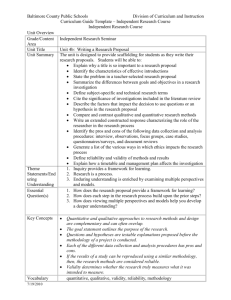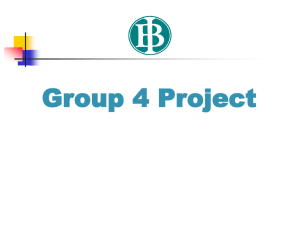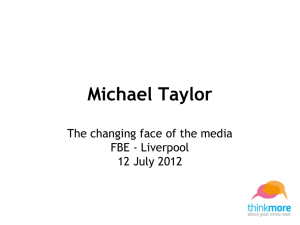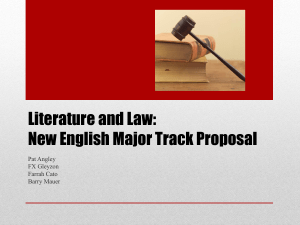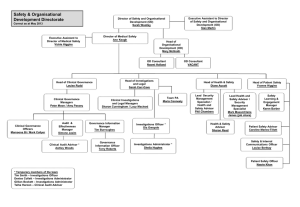Unit Overview for Step 4a - Key Elements of a Research Proposal
advertisement
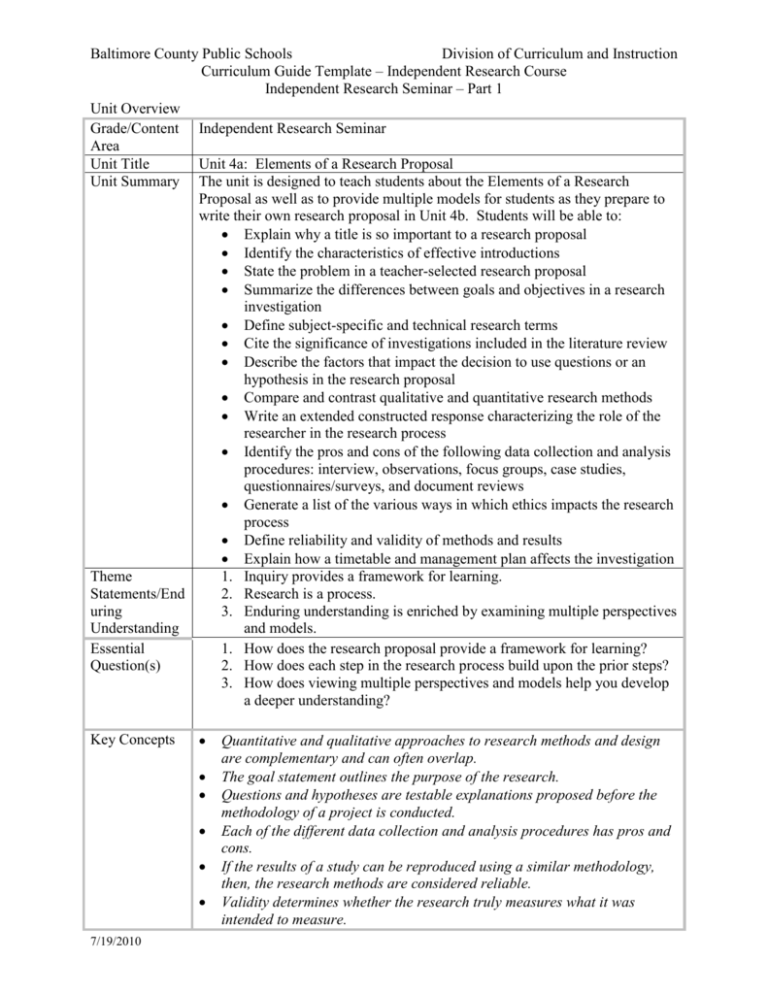
Baltimore County Public Schools Division of Curriculum and Instruction Curriculum Guide Template – Independent Research Course Independent Research Seminar – Part 1 Unit Overview Grade/Content Independent Research Seminar Area Unit Title Unit 4a: Elements of a Research Proposal Unit Summary The unit is designed to teach students about the Elements of a Research Proposal as well as to provide multiple models for students as they prepare to write their own research proposal in Unit 4b. Students will be able to: Explain why a title is so important to a research proposal Identify the characteristics of effective introductions State the problem in a teacher-selected research proposal Summarize the differences between goals and objectives in a research investigation Define subject-specific and technical research terms Cite the significance of investigations included in the literature review Describe the factors that impact the decision to use questions or an hypothesis in the research proposal Compare and contrast qualitative and quantitative research methods Write an extended constructed response characterizing the role of the researcher in the research process Identify the pros and cons of the following data collection and analysis procedures: interview, observations, focus groups, case studies, questionnaires/surveys, and document reviews Generate a list of the various ways in which ethics impacts the research process Define reliability and validity of methods and results Explain how a timetable and management plan affects the investigation Theme 1. Inquiry provides a framework for learning. Statements/End 2. Research is a process. uring 3. Enduring understanding is enriched by examining multiple perspectives Understanding and models. Essential 1. How does the research proposal provide a framework for learning? Question(s) 2. How does each step in the research process build upon the prior steps? 3. How does viewing multiple perspectives and models help you develop a deeper understanding? Key Concepts 7/19/2010 Quantitative and qualitative approaches to research methods and design are complementary and can often overlap. The goal statement outlines the purpose of the research. Questions and hypotheses are testable explanations proposed before the methodology of a project is conducted. Each of the different data collection and analysis procedures has pros and cons. If the results of a study can be reproduced using a similar methodology, then, the research methods are considered reliable. Validity determines whether the research truly measures what it was intended to measure. Baltimore County Public Schools Division of Curriculum and Instruction Curriculum Guide Template – Independent Research Course Vocabulary quantitative, qualitative, validity, reliability, methodology Alignment: AASL Standards for the 21st Century Learner: Standard 2.0 - Learners use skills, resources, and tools to draw conclusions, make informed decisions, apply knowledge to new situations, and create new knowledge. (2.0) 2.1.1 Continue an inquiry-based research process by applying critical-thinking skills (analysis, synthesis, evaluation, organization) to information and knowledge in order to construct new understandings, draw conclusions, and create new knowledge. 2.1.3 Use strategies to draw conclusions from information and apply knowledge to curricular areas, real-world situations, and further investigations. 2.1.4 Use technology and other information tools to analyze and organize information. 2.3.1 Connect understanding to the real world. Estimated Unit Length Learning Preferences Differentiation for Skills /Strategies Instruction Digital Content, Tools, and Resources Assessments (Completion of various research process steps) Independent Assignments (home, school, mentor) 7/19/2010 MD Technology Literacy Standards for Students: Standard 6.0 – Technology for Problem-Solving and Decision-Making: Demonstrate ability to use technology and develop strategies to solve problems and make informed decisions Step 3 - Carry Out the Plan • Collect data and information using technology tools • Use communication tools to gather information • Make and record observations using technology Seven Period Day: 8 days Four Period Day: 16 days Visual Auditory Kinesthetic Tactile Field Dependent Active Field Independent Reflective Global Sequential All digital content can be differentiated by lexile. Self-paced, online tutorials address specific deficits. Text-to-speech can be utilized as needed. Graphic organizers are provided to scaffold learning. http://www.bcps.org/offices/lis/researchcourse/develop.html http://www.bcps.org/offices/lis/researchcourse/key_elements.html http://www.bcps.org/offices/lis/researchcourse/develop_writing.html Reflection journals (9) Venn diagram Visual definition Online notebook Home assignments: reflection journals, online notebook, visual definition Baltimore County Public Schools Division of Curriculum and Instruction Curriculum Guide Template – Independent Research Course Lesson Titles Key Concepts/Big Standards Alignment Brief Description or Ideas Addressed in Overview Lessons “The Title Page” Word choices and 2.1.1 Continue an Explain why a title is syntax must be inquiry-based so important to a precise to convey research process by research proposal meaning.. applying criticalthinking skills (analysis, synthesis, evaluation, organization) to information and knowledge in order to construct new understandings, draw conclusions, and create new knowledge. “Effective Introductions” Effective introductions convey the nature, context, and scope of the research project. 2.1.1 Continue an inquiry-based research process by applying criticalthinking skills (analysis, synthesis, evaluation, organization) to information and knowledge in order to construct new understandings, draw conclusions, and create new knowledge. Identify the characteristics of effective introductions “Identifying the Problem” Enduring understanding is enriched by examining multiple perspectives and models. 2.1.1 Continue an inquiry-based research process by applying criticalthinking skills (analysis, synthesis, evaluation, organization) to information and knowledge in order to construct new understandings, draw conclusions, and State the problem in a teacher-selected research proposal 7/19/2010 Baltimore County Public Schools Division of Curriculum and Instruction Curriculum Guide Template – Independent Research Course create new knowledge. “Goals and Objectives in Research” The goal statement outlines the purpose of the research. 2.1.1 Continue an inquiry-based research process by applying criticalthinking skills (analysis, synthesis, evaluation, organization) to information and knowledge in order to construct new understandings, draw conclusions, and create new knowledge. Summarize the differences between goals and objectives in a research investigation “Research Vocabulary” Knowledge of subjectspecific vocabulary enhances understanding. 2.1.4 Use technology and other information tools to analyze and organize information. Define subjectspecific and technical research terms “Significance of Investigations” The significance of an investigation is determined by its importance to the individual conducting the research and its impact on society. 2.1.3 Use strategies to draw conclusions from information and apply knowledge to curricular areas, realworld situations, and further investigations. Cite the significance of investigations included in the literature review “Question or Hypothesis?” Questions and hypotheses are testable explanations proposed before the methodology of a project is conducted. 2.1.3 Use strategies to draw conclusions from information and apply knowledge to curricular areas, realworld situations, and further investigations. Describe the factors that impact the decision to use questions or an hypothesis in the research proposal “Qualitative and Quantitative Research Methods” Quantitative and qualitative approaches to research methods and design are complementary and can often overlap. 2.1.3 Use strategies to draw conclusions from information and apply knowledge to curricular areas, realworld situations, and further investigations. Compare and contrast qualitative and quantitative research methods 7/19/2010 Baltimore County Public Schools Division of Curriculum and Instruction Curriculum Guide Template – Independent Research Course “The Role of the The researcher’s role 2.1.3 Use strategies Write an extended Researcher” may affect the to draw conclusions constructed response methodology, from information and characterizing the role outcomes, and apply knowledge to of the researcher in analysis of findings. curricular areas, real- the research process world situations, and further investigations. “Data Collection and Analysis Procedures” Each of the different data collection and analysis procedures has pros and cons. 2.1.3 Use strategies to draw conclusions from information and apply knowledge to curricular areas, realworld situations, and further investigations. “Ethics in Research” Enduring understanding is enriched by examining multiple perspectives and models. 2.1.3 Use strategies to draw conclusions from information and apply knowledge to curricular areas, realworld situations, and further investigations. “Reliability and Validity” If the results of a study can be reproduced using a similar methodology, then, the research methods are considered reliable. Validity determines whether the research truly measures what it was intended to measure. A management plan increases the likelihood of successful completion of complex tasks. 2.1.3 Use strategies to draw conclusions from information and apply knowledge to curricular areas, realworld situations, and further investigations. Define reliability and validity of methods and results 2.3.1 Connect understanding to the real world. Explain how a timetable and management plan affects the investigation “Managing the Research” 7/19/2010 Identify the pros and cons of the following data collection and analysis procedures: interview, observations, focus groups, case studies, questionnaires, surveys, and document reviews Generate a list of the various ways in which ethics impacts the research process
